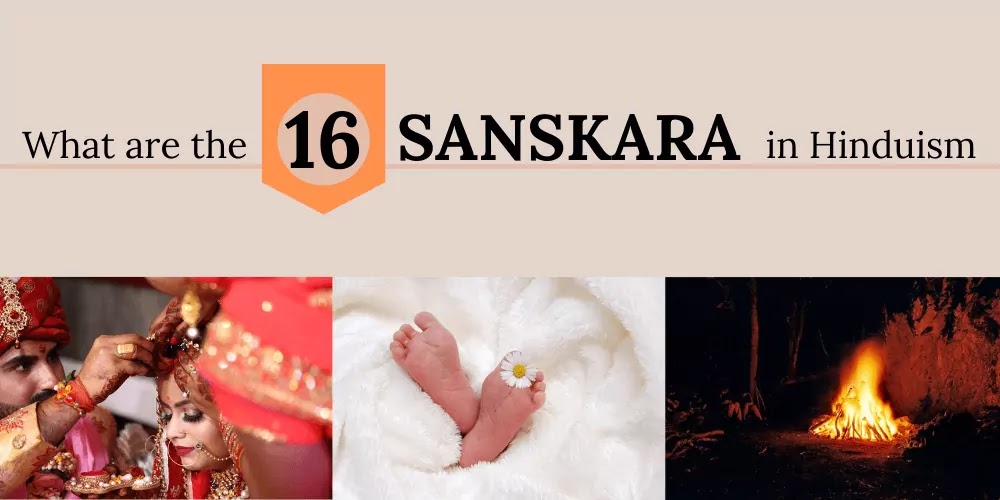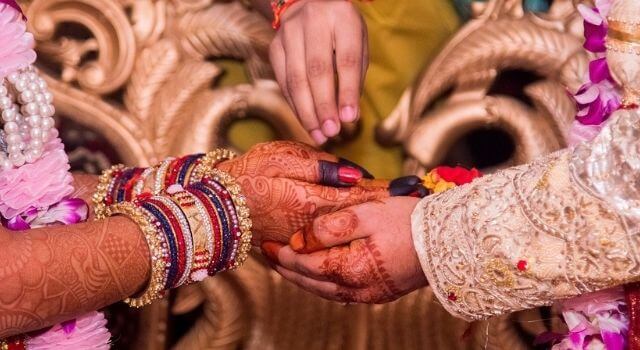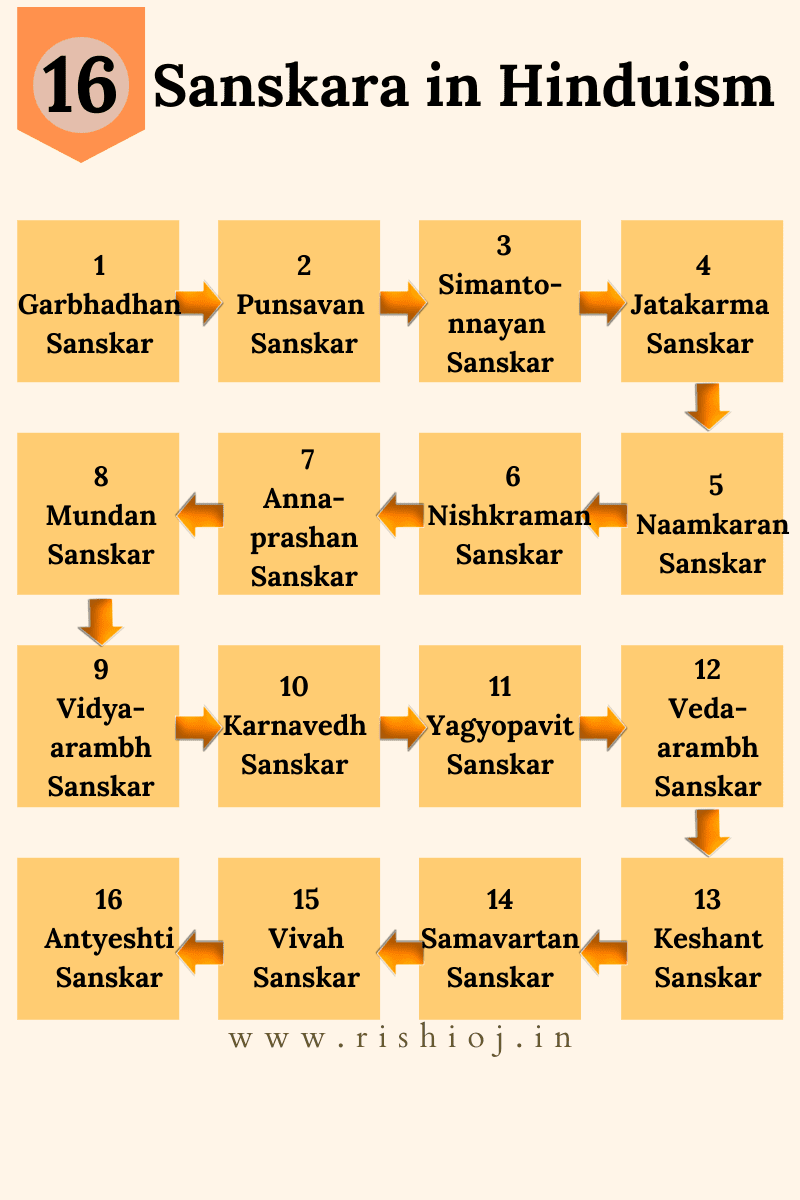Since the ancient days, the Hindu way of life has been brimming with rituals. Some of them are unknown to the modern generation but they hold their own meaning and significance. Although there have been about 40 hindu sanskars (sacraments) prescribed In the Vedas, Vyas smriti & other prominent Hindu shastras & scriptures, only 16 sanskaras or sacraments are being observed.
The 16 Sanskaras or sacraments in Hinduism and Their Significance
Sanskaras are celebrated with grandeur in the august presence of respected elders, scholars, near and dear ones. Everyone gets together to convey their best wishes and blessings to the person concerned and thus there is social & religious sanction for the act and ceremony. These sanskaras are meant to cultivate spiritual and other positive qualities which help purify person’s body and mind and ultimately lead to Realization, or union with God.
Of these Sanskars,
- The first three (Garbhadhan, Punsavana, Simantonnayan) are called Anthargarbha Sanskar.
- The next six are called Bahirgarbha Sanskar. Garbh Sanskar is also called Dosha Marjan or Shodhak Sanskar. The meaning of Dosha Marjan Sanskar is that the rites are performed to remove the defects related to dharma and karma from the previous births of the child and the deformities in the womb.
- The latter six sanskaras are called Gunadhan samskaras.
- The last one- Anteyshti – on the death.
Listed here is an introduction of these important 16 Sanskaras in Hinduism covering the entire life span of a person.
1. Garbhaadhan sanskar
This sanskar is done to bear progeny that brings good name to the clan. This is the first coming together of the husband and wife for bringing about conception. 'Garbha' means womb. 'Daan' means donation. In this sacrament the man places his seed in a woman. It is considered appropriate to conceive only on the basis of the particular date and the calculation of planets during the shubh nakshatra time .
Parents expecting a need to purify their body and mind through this first sanskar by chanting shlokas or mantras praying deities to bless the woman for a worthy, healthy child, One who is of virtuous character, intelligent, brave and patient, who takes the country and society forward.
2. Punsavana sanskar
This sanskar is performed after the third month of pregnancy is completed. This is the time when the brain of the foetus starts developing. This sanskar is considered useful from the point of view of pure, intellectual and mental development of the baby in the womb.
3. Simantonnayan Sanskar
This sanskar is done during the 4th, 6th and 8th month of pregnancy. Simantonanayan means 'simant'- the line of parting of hair and 'andyunnayan'- combing hair from the sides to the top. By combing in such a way the pleasant waves enter her body through Sahasrara Chakra. Along with preventing abortion, the main purpose of this rite is to protect the foetus and its mother. Through this sanskar, the pregnant woman is blessed to keep her mind peaceful, happy and pious.
4. Jatakarma sanskar ( the rite at birth)
In mother’s womb, the baby does not eat through his own mouth. Food reaches the baby through umbilical cord and the baby is wrapped in a pouch filled with water. This sanskara is performed on the birth of the child. It is said to be performed when cutting the navel string of the new born baby from that of his mother. Ghee and honey are given to the infant with a golden spoon or with the ring finger.
This sanskar ensures a lot of bad omens cleared from the infant. It is done for the health and longevity of the child.
In present times, since childbirth occurs in maternity hospitals, one cannot perform the sanskar of Jatakarma there. Therefore it is often done along with the rite of Namakaran (naming ceremony).
5. Naamkaran sanskar (The naming ceremony)
As clear from the name itself, this sanskar is done to decide the name of the infant. Our Dharmacharyas have considered asaucha (suaa) for ten days after birth. Therefore, it is a law to perform this sanskar on the eleventh day. but many ritualistic scholars consider it appropriate to perform this ritual on any first auspicious day after the birth.
The naming ceremony has more importance in Sanatan Dharma. Our sages have told the effect of name more because it helps in the development of personality. The science of astrology prepares the outline of the future on the basis of the name itself.
6. Nishkraman sanskar (The rite of taking the child out of the house)
In this ceremony, usually in the 4th month after birth, the child is taken out of the house for the first time by the parents and is made to look at the Sun for the first time. For three months the body of the infant is not adapted to the external environment like strong sunlight, strong wind etc. He should be kept in the house very carefully for three months. After this, gradually he should be allowed to invoke the blessings of five elements of the nature.
Its purpose is to make the child aware of the radiance of Lord Bhaskar(Sun) and the coolness of the moon. The significance of this sanskar is to bring the child in contact with the society and make him/her aware of the social conditions.
7. Annaprashana sanskar (partaking of the first solid feed)
This is done during the teething period of the child. After this, feeding the grains, cereal etc. is started.
The sixth or the eighth month in case of a boy and the fifth or any month with an odd number in case of a girl is favourable for the sanskar of Annaprashan.
Annaprashan means the infant, who has been living on drinks, especially milk (mother’s feeding), until now, taking his/her first solid food. This would make him physically and mentally strong and enlightened. The body remains healthy only by a pure, sattvik and nutritious diet. That is why this ritual has a special significance in infant’s life.
Feeding a baby with kheer and sweets is considered auspicious. 'Amritah Kshirbhojanam'- In our scriptures, Kheer is considered as good as nectar.
By promoting this sanskara, our wise sages accomplished two important considerations. First, the child is weaned away from the mother at a proper time. Second, it warns the mother to stop breast feeding the child. For, the continuous breast feeding to child is hazardous to both- herself and the child.
Read more topics:
8. Mundan Sanskar ( Choulkarma sanskar)
The removal of the hair is done during this sanskar. It is believed to strengthen the head of the child and also increase intellectual power. This is also known as the first haircut.
A small portion of hair known as the ‘lock or tuft of hair’ kept after the remaining part is shaved off. This facilitates the entry of the sattva frequencies from the universe through the Brahmarandhra- A spot on top of the head. It functions like the antenna of a television set.
[Refer ‘Science of Spirituality : Chapter 38 – Path of Activation of Spiritual Energy (Kundalini yoga)’.]
Our learned acharyas and gurus have prescribed to perform this sanskara in the first, third or fifth year of the child. Nowadays, however it is often performed along with the thread ceremony.
The purpose of Vidyarambh is to introduce the child to the elementary level of education. In my opinion the child starts speaking only after annaprashan. That is why Vidyarambha ceremony seems appropriate only after Annaprashan.
It is a sanskara about piercing the ears. It is believed to have some relationship with the brain and acupuncture. The basis of Karnavedha Sanskar is absolutely scientific. The main purpose of this sanskar is to protect the child from physical ailments. Ears are our hearing gates. Ear piercing cures diseases and increases hearing power. By piercing ear at the bottom a specific vein gets pierced which helps to avoid diseases like Hernia.
There is a law to perform this sanskar before the Yagyopaveet Sanskara. This sanskaar is usually carried out in 1st, 3rd or 5th year.
It is believed that when the sun rays pass through the tiny hole, the child becomes as bright as the sun.
It is done during the study of the child. Upanayana means bringing child to a teacher or guru. Yagyopaveet or Upanayana is important sacrament for intellectual, religious and spiritual advancement.
Our learned acharyas and gurus have prescribed to perform this sanskara in the first, third or fifth year of the child. Nowadays, however it is often performed along with the thread ceremony.
9. Vidyaarambha Sanskar
The purpose of Vidyarambh is to introduce the child to the elementary level of education. In my opinion the child starts speaking only after annaprashan. That is why Vidyarambha ceremony seems appropriate only after Annaprashan.
10. Karnavedh Sanskar
It is a sanskara about piercing the ears. It is believed to have some relationship with the brain and acupuncture. The basis of Karnavedha Sanskar is absolutely scientific. The main purpose of this sanskar is to protect the child from physical ailments. Ears are our hearing gates. Ear piercing cures diseases and increases hearing power. By piercing ear at the bottom a specific vein gets pierced which helps to avoid diseases like Hernia.
There is a law to perform this sanskar before the Yagyopaveet Sanskara. This sanskaar is usually carried out in 1st, 3rd or 5th year.
It is believed that when the sun rays pass through the tiny hole, the child becomes as bright as the sun.
11. Yagyopaveet or Upanayana Sanskar
It is done during the study of the child. Upanayana means bringing child to a teacher or guru. Yagyopaveet or Upanayana is important sacrament for intellectual, religious and spiritual advancement.
'Yajnopaveetam Param Pavitam' - Yajnopaveet, also known as Janeu, is the most sacred. Prajapati has naturally created it. There is also a scientific significance of wearing Yagyopaveet. The purpose of this sanskar is to motivate the child to be engaged in spiritual development along with a restrained life.
This sanskara is done for the starting the study of the Vedas for the acquisition of knowledge. After the Yagyopaveet, the children were sent to the Gurukuls to the qualified Acharyas or Gurus to study the Vedas and get acquainted with the specific knowledge. In Gurukuls, after the upnayan sanskar, the learned acharyas used to make his disciples promise to observe the fast of celibacy or brahmacharya, lead a restrained life and only after clearing the required exam by Guru he could study Vedas. This sanskar is performed in the 5th or 7th year from birth. The 5th year is considered more authentic. This rite is usually performed on Vasant Panchami.
12. Vedarambha Sanskar
This sanskara is done for the starting the study of the Vedas for the acquisition of knowledge. After the Yagyopaveet, the children were sent to the Gurukuls to the qualified Acharyas or Gurus to study the Vedas and get acquainted with the specific knowledge. In Gurukuls, after the upnayan sanskar, the learned acharyas used to make his disciples promise to observe the fast of celibacy or brahmacharya, lead a restrained life and only after clearing the required exam by Guru he could study Vedas. This sanskar is performed in the 5th or 7th year from birth. The 5th year is considered more authentic. This rite is usually performed on Vasant Panchami.
13. Keshant Sanskar
It is related to removing the hair(kesh). It is first shaving of the beard of the student. After completing the study of Vedas in the Gurukul, this ceremony is performed in front of the Acharya. In fact, this sanskar is an undertaking to bid farewell to the Gurukul and enter the homestead or Grahastha. After being proficient in Vedas, Puranas and various subjects, before the ceremonial rites of Brahmacharya, the hair used to be cleaned with chanting of mantras at an auspicious time.
14. Samavartan Sanskar (Giving up bachelorhood)
It is done to mark the re-entry of the teenager from the gurukul back to home and the society. It prepares the teenager for the further struggle of life. At the time of leaving the Gurukul, the disciple's Samavartan ceremony used to be performed after the keshant ceremony.
This involves a ritual sacrificial bath known as Awabhruth Snana. It is sacrificial because it marks the end of the long observance of brahmacharya. In this, there has been a rule to bathe with eight jugs filled with water containing aromatic substances and medicines. This bath was accompanied by special chanting and then Acharya used to confer the degree of Bachelor of Education to him. By this title, he was considered to be proudly entitled to enter the householder's home or grahastha.
15. Vivah Sanskar (Marriage)
It is one of the most important sanskaras done for marrying a person, basically oriented to keep the creation going on. This has been the most important ritual of household life. This is the biggest sacrament for both men and women in Hinduism, which takes place after birth. In this ceremony, two individuals seek the blessings of Almighty to lead a happy married life.
16. Antyeshti Sanskar or Antim sanskar (The Last Rites- funeral ceremony).
It is the last sanskar done after a person’s life-journey ends on this Earth. After demise, necessary Hindu rituals as prescribed in the Vedas or scriptures are performed and then the body is assigned or dedicated to fire. Thus the body which is made of five elements is remerged into those five elements.
Wealth will remain dormant, cattle will confine to the compound, (his) wife/spouse will accompany (him/her) upto the doorway, friends will escort him to the crematorium, the body will come till the funeral pyre, but on the path to the next world, the jiva goes alone (with his karmas).
Web-story








0 Comments
Please do not enter any spam link in the comment box.